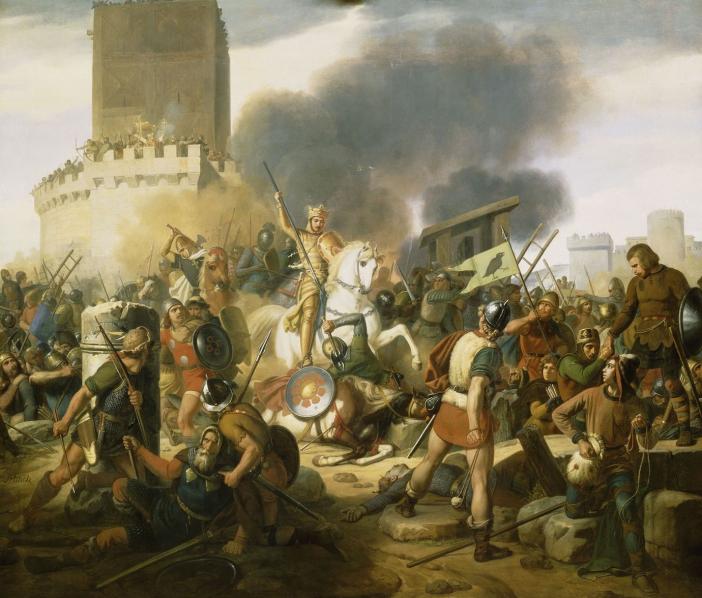Ragnar Lothbrok, the notorious Viking, is still a historical mystery veiled in myths, or even believed to be a collective personage for several different Viking leaders. He is the father of the famous Vikings Björn Ironside, Ivar the Boneless, Sigurd Snake-in-the-Eye, Halfdan Ragnarsson, and Ubba. However, history is most certain of one thing. Among all raids led by Ragnar, is the Vikings’ raid of Paris in 845. The adventurous Danish Viking Reginheri after a series of vicious attacks over the region of what was then Frankia and what would be later known as France managed to capture the city of Paris. His steps were followed by other great Viking leaders – Earl Siegfried and Rolf the Ganger.
At that time, Paris, a small walled island city on the Seine was the seat of the Frankish king Charles the Bald. After the first siege of Paris, the Frankish continued to experience attacks from the Norsemen, but would manage to withstand another besieging in 885.
The First Viking attack on Paris – 845
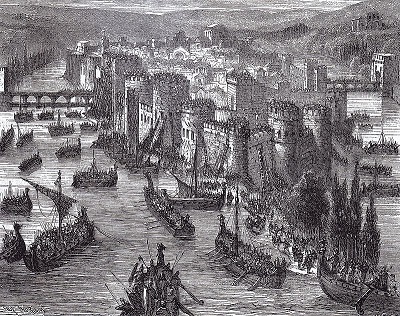
The year is 845. The city of Paris, situated on the small island Île de la Cité will wake up to the sounds of the city bell. The city was being attacked by the Norsemen who had been scavenging the area for the past four years, yet who had never tried taking over the city of Paris. The spring waters of the Seine brought over 120 Viking barques carrying 5000 warriors, under the command of the Danish Viking Reginheri. Before their arrival, they sacked the city of Rouen.
Chieftan Raginheri had a score to settle with the Frankish leader. Not so long ago, in 841, King Charles gifted him with lands in Turnholt, where the Vikings could build their settlement, but the Danish Chieftain soon lost the favor of the Frankish king.
King Charles, afraid of losing the Abbey of Saint-Denis to the Danes who were coming towards Paris, gathered his army. King Charles the Bald assembled his men, divided them into two garrisons, and ordered them to fortify on the two shores of the river Seine. The tactics of the Frankish leader, however, did not pay off and the Vikings effortlessly destroyed one of the garrisons, and even took prisoners.
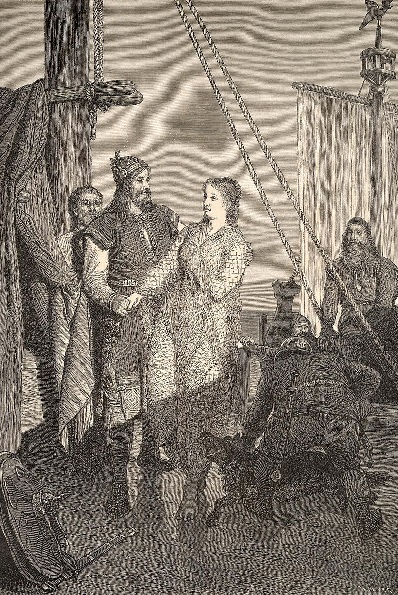
On the 28th and 29th of March, the Danes without much resistance or even need of a siege took over Paris. The fate of these 111 souls who the Norsemen captured when battling the garrisons was sealed. Their lives were sacrificed to the might of the Northerners’ God, the all mighty Odin.
The Price of Peace
The Frankish King Charles, afraid for the safety of the citizens of Paris and his own skin offered a tribute to Chieftain Raginheri. The freedom of Paris was worth 7000 pieces of silver and gold. Raginheri wanted revenge for the deeds of the Frankish king who paid the substantial amount. After the withdraw of Raginheri from the city some villages along the coast were still pillaged, that including the holy Abbey of Saint-Denis, which the king wanted to protect so much.
The same year, the Viking’s King Horik and his men ravaged the archbishopric city of Hamburg. The king of East Frankia sent his count Cobbo as a diplomat to resolve the issue with the Vikings and made a peace treaty with the Danish king.
As Raginheri returned to King Horik who was his superior, he explained the ease with which he entered the city yet lost many men to the plague at Saint Germain in Paris. King Horik, afraid the plague was a curse for the Vikings’ attack on the Abbey, ordered the execution of those raiders who survived and freed the captured Christian.
During 860 many of the villages around Paris and the city itself again suffered pillaging and ravaging attacks from the Norsemen. The King of West Frankia – Charles died in 877 and left the city in a chaotic state. As a result, several different rulers’ unsuccessfully reigned for short periods, and all failed to create a defense against the raging Vikings. At last, in 884, the King of Germany and Italy Charles the Fat took the throne of Frankia.
One year later, the river Seine once again carried Norsemen under the command of Earl Siegfried the Sinric. That time, the boats of the Northerners brought along another of their fiercest warriors, Rolf the Ganger, or Rollo. He raided the region of Neustria from 877. The legends said he was so big no horse could carry him and thus, he received his nickname The Walker.
This time, however, the Franks had learned their lessons and spent the last years improving their defense system in expectation of the next Vikings’ attack. Count Odo, son of Robert the Strong, followed his father’s example and took it upon himself to continue the fortification of Paris.
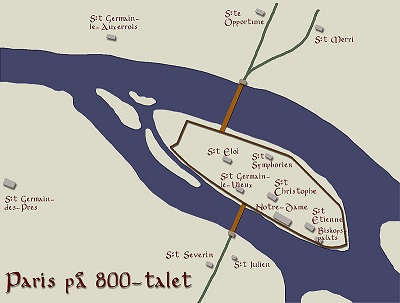
Alongside the river, he erected the defensive tower Grand Châtelet and two bridges, both with defensive towers on each end. Thus, in 885, the city of Paris was this time prepared to face the attack of the Vikings.
The Second Viking Siege of Paris 885-886
The great army of Vikings, possibly around a few thousand men, gathered in Rouen under the command of Siegfried the Sinric. Rouen, still remembering the last Vikings’ raid chose to surrender in order to avoid any harm.
The Vikings first demanded tribute from Count Odo the Protector of Paris, who refused. Siegfried then decided to lead his ships up the stream of the Seine. Yet, he had no idea that the Franks had built the two low bridges, one of stone and the other of wood, which made it impossible for the Vikings’ barques to pass the towers and reach the city of Paris. The towers themselves were heavily guarded by men of Count Odo, his brother Robert, and few other Parisian royals.
In late November the same year, the Danes asked for another tribute, which was again denied. In response, they began their attack on the Grand Châtelet on the right bank. The Norsemen used mangonels and catapults to hurl large pieces of stone and javelins, and started to climb the walls but the defenders poured boiling oil and wax on them. At sundown the Vikings ceased their attempts and regrouped, the Parisians used the night and rebuilt their tower. After seeing the renewed tower the next morning, the Danes concentrated on taking down the city gates, again with no success.
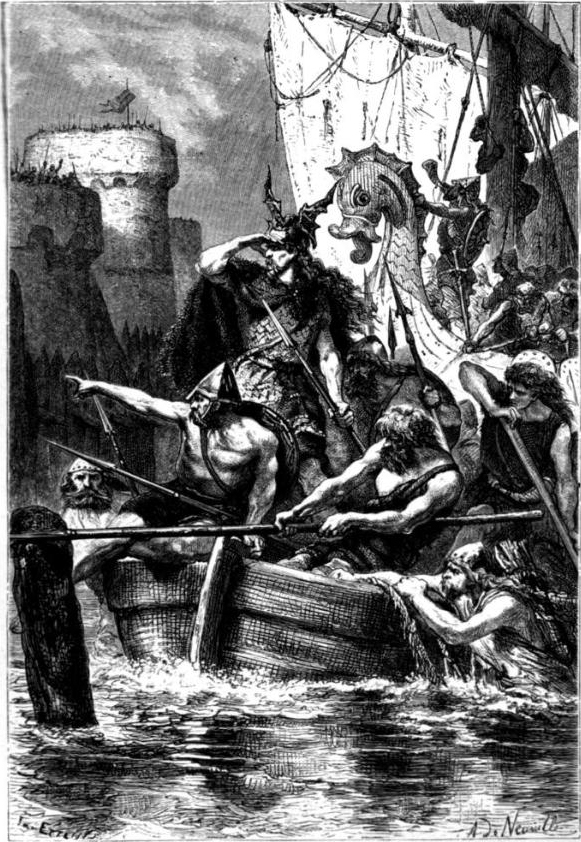
Following the coming of the night, the Vikings crossed the river and made a camp on the opposite bank and continued building siege weapons. Next day, they renewed their efforts, throwing something similar to grenades and trying to take down the tower and enter the city. The siege of the Vikings continued for 2 months, during which they made incredible efforts and tactics in order to enter the city and scavenged the lands for provisions.
In February 886, the Vikings made an attempt to take down the wooden bridge by setting it on fire with burning boats, again with no success. However, the bridge’s weakened support got destroyed by the flood and debris after a heavy rain. With the bridge’s tower and its defenders left isolated, it was an easy target. Since the Parisian warriors who were fortified inside refused to give themselves up peacefully, the Danes killed them once the tower was stormed.
Tired of standing in one place, the Vikings separated into groups, leaving some to continue the siege, while others went on and pillaged the nearby lands. This gave count Odo the opportunity to send for help, and soon the Vikings that were still holding the siege were attacked from the back. Earl Siegfried, knowing his men were weary and weakened asked one more time for a small tribute of around 60 pounds of silver and left the siege in April.
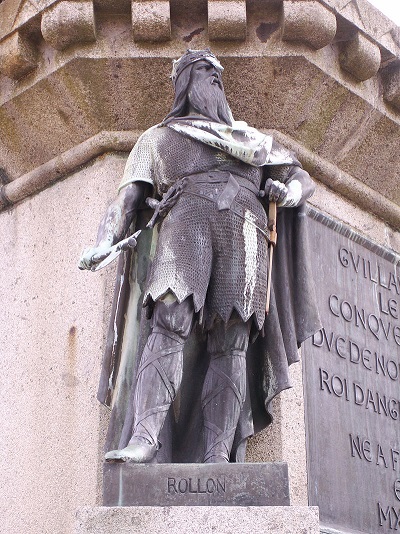
The Vikings who maintained the siege were Rolf the Ganger and his men. After several clashes with the Parisians, the Vikings managed to capture and kill Count Henry of Saxony and made another attempt to take the city in the summer but were again repulsed. The Imperial Army, the hope of Count Odo, arrived in October and quickly scattered the Norsemen and put an end to the siege.
King Charles and his imperial army instead of hunting the Norsemen down, sent them sailing up Yonne to the revolting Burgundy and promised them 700 livres for dealing with the revolt, which he paid upon their return in 887.
The Beginning of the Norman Dynasty
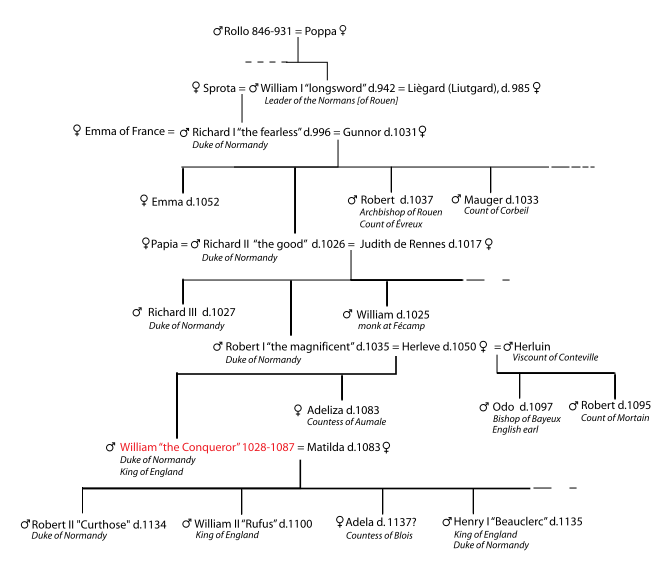
The Vikings sailed back to their land, but again in 911 Rolf returned to the lands of Frankia with the intent to raid and sack. However, Charles the Simple negotiated with Rolf, made him a count and married him to his daughter Gisela and gave him the city of Rouen. He later divorced Gisela and remarried his former wife, Poppa. The County of Rouen later, around the 11th century became the Duchy of Normandy, and the dynasty of Rolf continued ruling the lands and expanding their territories.
